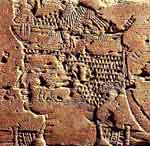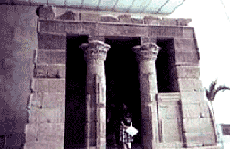HistoryKush and RomeIn 30 BC, the Romans replaced the Ptolemies as Kush's northern neighbors. Ancient Hellenic sources, and archeological evidence, reveal a military clash that took place between Kush and the Romans during the reigns of Roman Emperor Augusts and Kushite Queen Amanishekhato. The clash began as a border conflict. Prior to the conflic, the Romans struck a deal with the Kushite officials at Philae. The deal established Aswan, in Lower Nubia, as the official border between Kush and the Roman empire. Accordingly, the Romans were not permitted to expand their territorial ambitions south of Aswan. The Kushites, in return, were expected to pay a tribute to Rome1.
In the mid-to-late twenties of the first CE, revolts broke out in Thebes in protest of the Roman policy of excessive taxation.2 The revolts, which were probably supported by Kush, grew and spread throughout Lower Nubia and Upper Egypt. Tensions with Kush boiled when the Romans expressed interest in controlling Wadi Allaqi,3 which was rich in gold. The Wadi lies southeast of the Dodekaschoinos in Lower Nubia and was considered to be Kushite territory. In 24 BC, the Roman authorities in Egypt got occupied with conflicts in Arabia. The Kushites took advantage of the situation and descided to make a move. Under the leadership of Queen Amanishekhato, a Kushite military attacked the Roman garrison in Aswan. From there, the Queen led her military all the way to Thebes and defeated the Roman garrison there. Strabo the geographer, who lived in first century CE, reported that the Kushite Queen "enslaved the inhabitants, and threw down the statues of Caesar." (Strabo xvii.54). Recent archeological work uncovered a statue of Caesar at Meroe buried under the entrance floor of a temple at Meroe (currently in the British museum, London), which confirms the authenticity of Strabo's story. (The burying of the statue under the temple's floor, probably reflects the Kushite belief in the power of representation. By stepping on the depiction of an enemy, the Kushites believed that the power of the enemy would be magically weakened).5 Strabo wrote about the bloody conflicts that ensued between Kush and the Romans under the leadership of General Aelius Petronius.4 However, since Strabo was pro-Roman, and was a personal friend of Petronius, he patronized the Romans side of the conflict. According to Strabo, following the Kushite advance, Petronius (a Prefect of Egypt at the time) prepared a large military and marched south. The Roman forces clashed with the Kushite armies near Thebes and forced them to retreat to Pselchis (Maharraqa) in Kushite lands. Petronius, then, sent deputies to the Kushites in an attempt to reach a peace agreement and make certain demands. Quoting Strabo, the Kushites "desired three days for consideration"6 in order to make a final decision. However, after the three days, Kush did not respond and Petronius advanced with his armies and took the Kushite city of Premnis (modern Karanog) south of Maharraqa. From there, he advanced all the way south to Napata, the second Capital in Kush after Meroe. Petronius attacked and sacked Napata causing the son of the Kushite Queen to flee. Strabo describes the defeat of the Kushites at Napata, stating that "He (Petronius) made prisoners of the inhabitants".
This was not the end of the war. The Kushite Queen attacked the occupying
Roman garrison of Napata, in the words of Strabo, "with an army
of many thousand men." The Kushites, however, lost the war. The
Queen then sent messengers to Petronius requesting to speak
to the Roman Emperor. In response, Petronius sent the Kushite messengers
to Caesar, who was in
The Dendur Temple was given to the United States by Egypt in 1965 and is currently housed at the Metropolitan Museum of Art in New York. The temple was built in 15 BC, in honor to the goddess Isis. Motifs and the name of the Roman Emperor Augustus are carved and inscribed on the temple's walls. Also inscribed are the names and motifs of the two sons of a Kushite queen (Pihor and Pedesi), who participated in building portions of the temple. The Dendur Temple stands as a testament to the peaceful relations the Romans and the Kushites have maintained for the next seven centuries.
Edited: Jan. 2008. |




